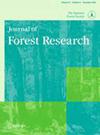通过种植收获创造的早期演替栖息地有益于灰夜莺(Caprimulgus jotaka):一项在日本北部北海道中部进行的为期8年的调查
IF 1.1
4区 农林科学
Q3 FORESTRY
引用次数: 0
摘要
摘要早期演替栖息地及其相关物种在全球范围内一直在减少。相比之下,种植园一直在扩大,其幼龄期(林分年龄≤10 年)可以作为早期演替的栖息地。灰夜莺(Caprimulgus jotaka)是一种夜间鸟类,在森林环绕的早期演替栖息地繁殖和觅食;自20世纪70年代以来,日本的人口一直在减少。由于夜壶在日本北部北海道的温暖地区更为丰富,通过种植园采伐创造栖息地有望促进该地区夜壶的丰富或占有。为了探讨人工林采伐对夜壶占用率的影响,我们在北海道中部的一个人工林景观中进行了一项为期8年的回放调查。我们认为海拔的影响是温度的替代因素。结果表明,幼林覆盖率在500以内 每个场地质心的m增加了夜壶的占用率,而高程对占用率产生了负面影响。因此,我们预测,在海拔较低的地区,随着人工林采伐后幼林覆盖率的增加,占用概率会增加。我们的研究结果表明,在景观中创造年轻的森林有助于灰夜莺的保护。为了通过人工林采伐有效地创造早期演替物种栖息地,重要的是要考虑目标地区的气候和海拔。本文章由计算机程序翻译,如有差异,请以英文原文为准。
Early successional habitats created through plantation harvesting benefit the Gray Nightjar (Caprimulgus jotaka): An 8-year survey in central Hokkaido, northern Japan
ABSTRACT Early successional habitats and their associated species have been decreasing globally. In contrast, plantations have been expanding and their young stages (stand age ≤ 10 years) can serve as early successional habitats. The Gray Nightjar (Caprimulgus jotaka), a nocturnal bird species, breeds and forages in early successional habitats surrounded by forests; its populations have declined since the 1970s in Japan. Because nightjars are more abundant in warmer areas across Hokkaido, northern Japan, habitat creation through plantation harvesting was expected to promote nightjar abundance or occupancy in this region. To explore the effects of plantation harvesting on nightjar occupancy, we conducted an 8-year playback survey in a plantation landscape in central Hokkaido. We considered the effects of elevation as a surrogate for temperature. The results indicated that increasing young forest cover within 500 m of the centroid of each site enhanced nightjar occupancy, whereas elevation negatively affected occupancy. Therefore, at lower elevations, we predict a larger increase in occupancy probability with increasing young forest cover following plantation harvesting. Our results suggest that young forest creation in landscapes can contribute to Gray Nightjar conservation. To effectively create early successional species habitats through plantation harvesting, it is important to consider climate and elevation in the target area.
求助全文
通过发布文献求助,成功后即可免费获取论文全文。
去求助
来源期刊

Journal of Forest Research
农林科学-林学
CiteScore
3.00
自引率
6.70%
发文量
62
审稿时长
3 months
期刊介绍:
Journal of Forest Research publishes original articles, reviews, and short communications. It covers all aspects of forest research, both basic and applied, with the aim of encouraging international communication between scientists in different fields who share a common interest in forest science.
 求助内容:
求助内容: 应助结果提醒方式:
应助结果提醒方式:


